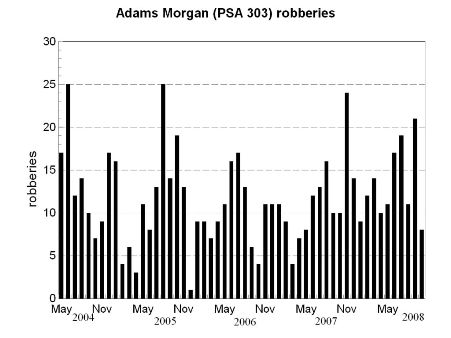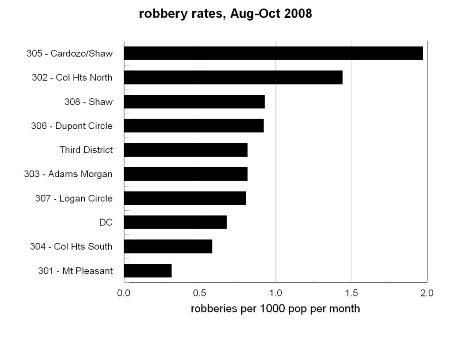Is there a violent crime wave in Adams Morgan?
Pardon me for
being a skeptic, but when people complain of crime waves in their neighborhoods,
I have to ask if this is something real, or just media-driven hysteria? Sure,
sometimes increases in crime are due to real changes, and call for urgent
responses. Some years ago, little bands of robbers from the Maryland suburbs
were cruising our neighborhoods, looking for people to rob, and the surge in
robberies was real. But other times, the usual ups and downs of crime are turned
into local panics, and residents call urgently for increases in police on
patrol, even though nothing really has changed.
 Lately some residents of Adams Morgan have been complaining
of a wave of violent crime. Is this something real, or just a normal variation?
Let's take a closer look. I plot here the number of robberies per month, since
the formation of the current PSAs in May, 2004. (Robbery is by far the most
common crime of violence. Adams Morgan averages 13 robberies a month, but only 4
assaults, while sexual assaults and homicides are, happily, very
rare.)
Lately some residents of Adams Morgan have been complaining
of a wave of violent crime. Is this something real, or just a normal variation?
Let's take a closer look. I plot here the number of robberies per month, since
the formation of the current PSAs in May, 2004. (Robbery is by far the most
common crime of violence. Adams Morgan averages 13 robberies a month, but only 4
assaults, while sexual assaults and homicides are, happily, very
rare.)
Yes, the frequency
of robberies in Adams Morgan increased in September to 21 in the month, well
over the average of 12 or 13 in a month, and almost twice the 11 reported in
August. Then, in October, the count dropped to just 8. Was this due to
effective police action, or was it just the usual variation in robberies, month
to month? Dramatic ups and downs in the monthly robbery count are frequent. In
July there were 19, almost as many as in this September "crime wave". Why the
decrease from 19 to 11, July to August? Why the increase from 11 to 21, August
to September? Was policing work so highly variable, month to month? Or are these
sharp increases and decreases simply the intrinsic variability of the
statistic?
Maybe one needs to know the robbers to understand why the
count changes so much. But it's apparent that it does change, doubling
sometimes, halving others, for no clear reason. Maybe it's weather. Maybe the
guys who do this sort of thing work in bursts, then lie low for a while. If a
robbery decrease is due to effective police activity, does an increase mean that
the police aren't doing their job? I doubt it -- I think the police pretty
steadily do their best, and they really have little control over the frequency
of robberies in any neighborhood.
The popular "police presence" specifically is
not effective at reducing robbery rates, not if those police are visible, in
uniform, or in marked squad cars. Robbers aren't the smartest folks on earth,
but they're smart enough to do their robberies when there are no cops in sight.
It's possible that the Metropolitan Police (MPD) are doing the right thing, by
fielding plain-clothes officers in likely robbery locations, hoping to catch a
robber who thinks that that guy hanging on the corner is just hanging on the
corner. The plainclothes officers I've seen are really good at looking like
street thugs.
Adjacent PSAs
 What of the neighboring PSAs during this same
September-October period? If their robbery rates followed the same pattern as
Adams Morgan, perhaps one could conclude that something was going on area-wide
that was changing the frequency of robberies. If their robbery rates didn't
track with Adams Morgan, one would have to conclude that something different was
happening there, such as increased police effectiveness.
What of the neighboring PSAs during this same
September-October period? If their robbery rates followed the same pattern as
Adams Morgan, perhaps one could conclude that something was going on area-wide
that was changing the frequency of robberies. If their robbery rates didn't
track with Adams Morgan, one would have to conclude that something different was
happening there, such as increased police effectiveness.
Well, there's no matching decrease
in Columbia Heights, just to the northeast of
Adams Morgan. That's the case also for PSAs 304,
305, and 306 (208). Only in Adams Morgan did the robbery count decrease markedly, September
to October. So perhaps one has to conclude that, whatever was done in Adams Morgan to
reduce the number of robberies, it worked.
Robbery
rates
These charts show the number of robberies in each PSA. But
what one really wants to know is, how many robberies are there per resident? Our
PSAs differ greatly in population, so a larger number of robberies, such as is
apparent in Dupont Circle, may correspond to a smaller number per capita. What
Joe and Jane Resident want to know is, how great is the threat to them and their
friends and family?
This chart shows the robbery rates, in robberies per
month per 1000 residents, averaged over the three-month period of August through
October, in order of decreasing robbery rate. What leaps out from this chart is
that two Third District PSAs, namely 305 (U Street/Cardozo/Shaw) and 302 (North
Columbia Heights) are suffering from the highest robbery rates in the district.
Dupont Circle and Adams Morgan are pretty close to the 3D average, as is Logan
Circle. The robbery rates in South Columbia Heights and Mount Pleasant are below
even the District-wide average for the period.
 So, why is Adams Morgan getting all
this attention, including evidently some focused police action that is
significantly reducing the robbery rate? You would think that PSAs 302 and 305
would warrant the special attention, not 303.
So, why is Adams Morgan getting all
this attention, including evidently some focused police action that is
significantly reducing the robbery rate? You would think that PSAs 302 and 305
would warrant the special attention, not 303.
If the police were left to
their own devices, I'm certain that they would focus their resources on the
areas where the crime rates are highest. But the MPD knows who pays the bills,
and who calls the shots. So when residents in politically influential
areas call for police resources, they get them. Residents of neighborhoods not
complaining so loudly, or lacking in political influence, don't.
So apparently the
police have succeeded in bringing the robbery rate down in Adams Morgan, and
shortly all parties will declare victory and move on. Meanwhile, robberies in
the not-so-influential neighborhoods will continue. And in due course, robberies
in Adams Morgan will resume, too. As long as we're trying to solve the crime
problem by arresting and incarcerating every criminal we can get our hands on,
crime will continue. The police will be the first to agree that we cannot arrest
our way out of this societal problem, which has its origins in poverty, poor
educations, and poor youth guidance. But what people want is an immediate fix,
ideally by capturing the guys doing the bad deeds and sending them away.
Proposing long-range solutions, by means of better education, better job
opportunities, better youth guidance, doesn't solve the immediate problem of
safety right now for you and yours.
Comparing robbery rates in the Third District
Back to home
This page created November 18, 2008
 Lately some residents of Adams Morgan have been complaining
of a wave of violent crime. Is this something real, or just a normal variation?
Let's take a closer look. I plot here the number of robberies per month, since
the formation of the current PSAs in May, 2004. (Robbery is by far the most
common crime of violence. Adams Morgan averages 13 robberies a month, but only 4
assaults, while sexual assaults and homicides are, happily, very
rare.)
Lately some residents of Adams Morgan have been complaining
of a wave of violent crime. Is this something real, or just a normal variation?
Let's take a closer look. I plot here the number of robberies per month, since
the formation of the current PSAs in May, 2004. (Robbery is by far the most
common crime of violence. Adams Morgan averages 13 robberies a month, but only 4
assaults, while sexual assaults and homicides are, happily, very
rare.) What of the neighboring PSAs during this same
September-October period? If their robbery rates followed the same pattern as
Adams Morgan, perhaps one could conclude that something was going on area-wide
that was changing the frequency of robberies. If their robbery rates didn't
track with Adams Morgan, one would have to conclude that something different was
happening there, such as increased police effectiveness.
What of the neighboring PSAs during this same
September-October period? If their robbery rates followed the same pattern as
Adams Morgan, perhaps one could conclude that something was going on area-wide
that was changing the frequency of robberies. If their robbery rates didn't
track with Adams Morgan, one would have to conclude that something different was
happening there, such as increased police effectiveness. So, why is Adams Morgan getting all
this attention, including evidently some focused police action that is
significantly reducing the robbery rate? You would think that PSAs 302 and 305
would warrant the special attention, not 303.
So, why is Adams Morgan getting all
this attention, including evidently some focused police action that is
significantly reducing the robbery rate? You would think that PSAs 302 and 305
would warrant the special attention, not 303.